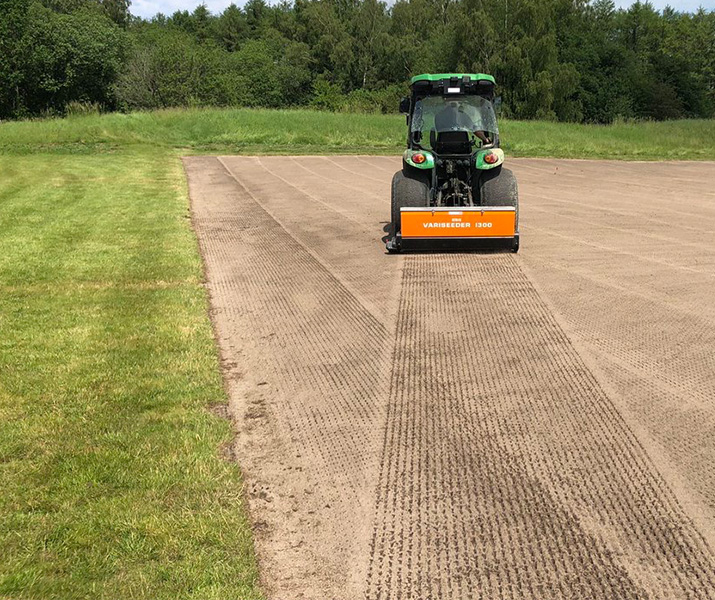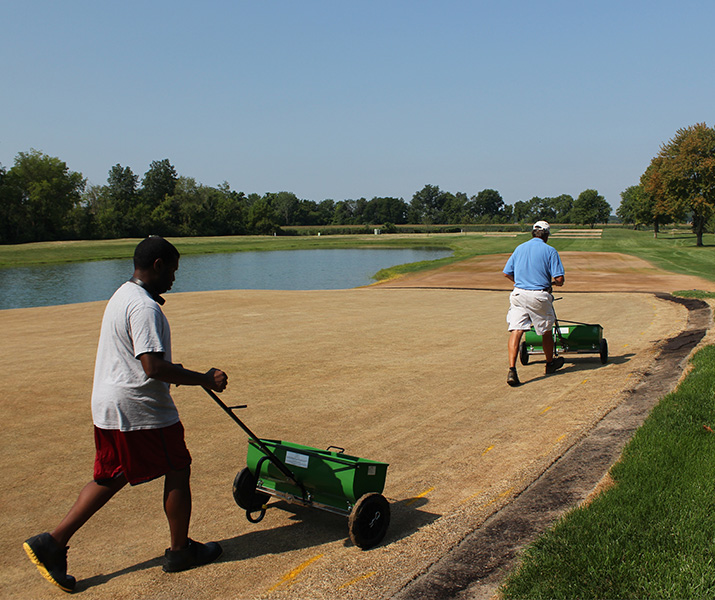After growing up in the golf industry, Agronomist and Golf Course Consultant Lew Sharp has just about seen it all. In fact, there isn’t much within the golf community that he hasn’t touched. From golf course construction, design, renovation, managing clubs, you name it—he speaks from experience.
And knowing how intimidating it can be to begin planning for a golf course renovation, he offers some counsel so that you don’t miss anything in your next big (or small) renovation project.
Problem solving: Do we need to renovate or repair?
To answer this question, you’ll need to pay close attention to the course itself. Most surface-level issues can be remedied with simple repairs. Maybe your soil is in good shape and the understory of your green is fantastic. If you’re just looking to get rid of poa or improve the existing stand of your greens, then interseeding might be the only solution you need. Or, maybe you have a green that’s too close to trees, and you want to improve the type of grass you have in that location. In that case, Tee-2-Green offers Crystal BlueLinks that will withstand shade and provide a much-needed upgrade.
However, if everything beneath the canopy is failing, simple solutions just won’t do. A few questions can help you discern if that’s the case:
- Are you losing turf grass on the green?
- Do you have poor drainage?
- Is the overall performance in the greens lacking?
- Have applications of fungicide and fertilizer stopped working altogether?
If you find yourself answering “yes” to these questions, it’s time for a renovation.
Financing: How much will it cost?
There are a couple of ways to determine costs for a renovation. If you already have plans for a renovation, and are choosing to keep the work in-house, you can start researching what the materials and labor will cost. This helps build a better frame of reference for budgeting. After that, it’s just a matter of crunching numbers.
If you’re opting to go with a construction company or contractor, start making calls to have them come in and prepare bids for the work. I recommend reaching out to several different options to compare costs and find what works best for your budget.
However, if you’re still needing a master plan for a renovation, there are some key steps that will need to be completed before determining the financial investment needed for your project.
Clarify goals
First and foremost, you’ll want to sit down and meet with your greens committee to discuss what everyone’s goals are for the project. I can’t stress this enough. Clarifying goals upfront will benefit everyone involved, so make it a priority to have this conversation before you do anything else.
Match with the right architect
The next step is to find an architect that best fits your course’s needs. For example, if you have a Donald Ross-type course, seek out an architect that specializes in that specific course design. If you’re wanting to rework a few hole layouts or move some bunkers, etc., they will know how best to approach your renovation, and will save you time—and money—in the process.
Seek a consultant
After meeting with an architect, you’ll walk away with a cost estimate that you can use to compare with your actual budget. It’s a good idea to pursue a consultant or intermediary to gauge if the numbers are fair, or if there might be more affordable construction companies available. A consultant can also tailor the plans by knowing the area, topography, soil types, sun/shade ratio, and which grasses will work best for your course. Additionally, they can also help determine ideal products and mixes for applications going forward.
Irrigation and drainage
Make sure to prioritize finding an irrigation consultant, along with an engineer for drainage. Proper irrigation and drainage will significantly improve turf health, visual appeal, and most importantly, a property’s cost savings. Irrigation consultants are helpful in determining irrigation design and purchasing equipment, but they also monitor the bidding process, provide unbiased contractor reviews, and aid with construction management.
Legal Matters
Lastly, when working with a construction company or contractor, they will also have someone to handle all the proper contracts and legal matters required by the state. This includes compliance with applicable building codes, local laws and ordinances, and any other county-specific restrictions that might be in place. For those keeping renovations in-house, it’s a good reminder to prepare yourself for the amount of behind-the-scenes work involved in addressing these steps effectively.

Timeline: How long will it take?
There’s a difference between a timeline and a realistic timeline. Members and stakeholders will want the golf course closed for the shortest amount of time, period. Often, they’d even like us to work some magic for the green to be open by a set time and date. Although I wish things could always work that way, it’s simply unrealistic to expect that precise of a completion. There are just too many factors at play to consider.
The standard—or usual—time frame to expect for a major renovation is 12-16 months. Some extremes do apply. For instance, if you’re only resurfacing the top and adding sand, that can be done in six months. If you’re redoing all the greens, fairways, complexes and tees, it can take upwards of 16-18 months.
Each course and each context will be different, so make sure you factor in all the logistics before communicating the timeline for the project. As with anything, it’s important to be honest and realistic when setting expectations
Staffing: Who will do the work?
A lot of golf courses want to complete a renovation in-house to save money. Although the motive makes sense, few courses are able to pull it off for a few reasons.
To start, the size of your course is an important factor to consider. For example, smaller courses might have the capacity to complete a renovation with the right crew size and equipment. Pinehurst, on the other hand, might be able to do a few greens, but with their size, there’s no way for them to complete all 18 holes, internally.
The other aspect to think about is staff experience. How qualified are the staff members to take on such a project? When doing a renovation, you need to have the knowledge to do it right. Some clubs like Fort Wayne Country Club do all of their renovations in-house, but their average staff tenure is around 18-20 years, so they’re well-equipped with various skill sets. For most other clubs I talk to, it just makes sense to hire a construction company to do the work.

Communication: How do we keep everyone on the same page?
My advice is to open up every avenue of communication possible. This goes for everyone involved—club members, community members, and stakeholders. Also, if there’s a homeowners association close by, include them, too. Some homeowners on-site are not members of the golf course—they may have bought their home for the view and tranquility the location offered.
It’s vital that everyone is given realistic expectations and clear communication throughout the process. Tell them, “this is what’s going to happen, and this is the window of time it will take to complete it.”
Further, I’d even recommend taking an extra step and reaching out to those outside of the community as well. Give them a glimpse of what you’re accomplishing and what the golf course will look like when all is said and done. Getting the word out will draw more members and might also result in more public play in the near future.
And for those worried about having so many people involved, I have found that it’s always better to let them know what the expectations are ahead of time. You will save yourself a lot of hassle and stress if you make that your focus.
Final thoughts
Golf course construction, or renovation, can either be a lot of fun or a real pain—the biggest difference is having the right people in place.
One last recommendation I’d like to give pertains to changes in leadership or management that might occur during—or after— construction. I’ve seen it a few times where a former superintendent is kept until construction is completed, and then is replaced shortly after. If this is planned for your project, my advice is to bring in the new superintendent and have them involved in the process. If a hole is dug, they should know what went in it. Further, it’s a great idea to have them familiar with where main lines, irrigation, and electrical are placed.
If it’s brand new construction, take pictures and document these things and be as specific as possible. Ask yourself, “What would I need to know if I was handed this position and responsibility?” Then make the effort to provide those resources accordingly. You’ll set your team up for success, and in the long run, I guarantee it will be worth it.




